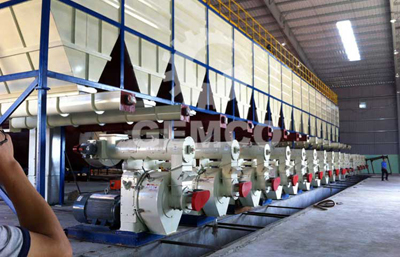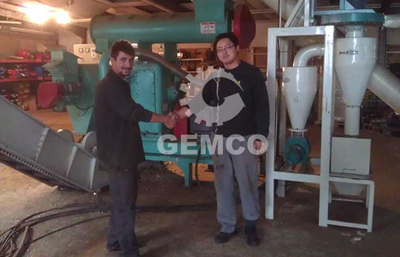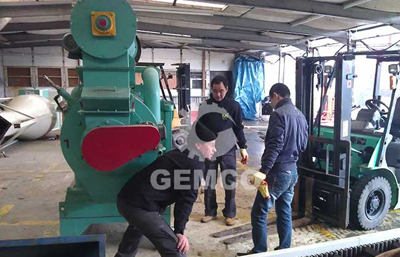Biomass energy advantages and disadvantages
Biomass energy refer to the energy from plants and animals, mainly composed of organic matters. It is the chemical form of solar power deposited in organisms. Generally, it has 4 sources, agriculture biomass, forestry biomass, urban solid waste, and energy crops.
These biomass materials can be molded into pellets or briquettes under high pressure. They are called biomass molding fuel. These biomass fuels has high density and heat efficiency, widely applied in heating stoves, boilers and power plants.
Advantages of biomass fuel
Good burning effect
Biomass fuels have high heat value. For wood pellets, the heat value is 4300-4500 kcal/kg. For crop pellets, the heat value is 3500-3800 Kcal/kg. Although they don't reach the coal’s 4900 kcal/kg, with less ash and slag residues, their heating effects are similar with medium coals.
According to industrial analysis, the biomass fuels contains high volatiles content. In terms of corn stalks and sawdust, their volatiles content can be 70-90%. This means biomass fuels have high ignitability.

Clean and less pollutant emission
Burning coals will generate large quantities of NOx, CO2, SO2, as well as suspended particulate matter, ash and slag. They are pollutant to the environment and have been restricted in many placed.
Burning biomass fuels can significantly reduce CO2 emission. As biomass contains little sulfur, there is no SO2 emission. Besides, biomass fuels has less fly ash, slag, or heavy metal discharge. Therefore, biomass fuel is known as clean and green energy.
Rich resources and low price
Biomass energy is the world’s 4th largest energy. As estimated by biologist, the land generate 100-125 billion tons of dry biomass every year, and the ocean generate 50 billion tons of dry biomass. Farms and forestry can provide abundant biomass resources that we can make use of.
In this regard, biomass energy is a renewable energy with large output and stable supply. Meanwhile, as the biomass materials cost low, and the manufacturing cost is much lower than coal and oil, it has significant price advantages and promotes more easily.

Mature processing technology and equipment
To make use of biomass energy, we usually mold the bulky materials into briquettes or pellets. Pellet mill and briquette press is used to mold the biomass materials with high pressure and temperature. They can soften the raw materials and squeeze them into a die or mold, so as to increase the density dramatically.
The molding process includes raw material crushing, drying, molding, cooling and packing, etc. First, we need to crush the raw material to reduce the size to under 5mm, then lower the moisture content to 15-20% with a drum dryer or in the sunlight. After that, we can use the molding equipment to make biomass fuels.
According to different molding structure, the molding equipment can be classified into 4 types: stamping briquette press, screw extruding briquette machine, ring die pellet machine, and flat die pellet machine.


Disadvantages of biomass fuel
Unevenly distributed and low density
Although biomass resources are abundant, they distributed unevenly all over the world. With irregular shapes and low density, the biomass materials usually take up large places, costing high for storage and transportation.
Taking rice husks for example, its natural stacking density is only 83-160kg/m3. The fixed carbon content is 10-15%, and the heat value is 3000kcal/kg, equal to half of 1kg coal. So the energy density is rather low. To mold it into briquettes or pellets can increase the density to 1000—1200kg/m3. But the molding equipment and process will increase the use cost.
These defects hinder the application of biomass fuel. Currently, to increase the energy density is a key project in the development of biomass energy.

Ash and slag deposition and corrosion
Biomass materials usually contains high alkali metal (Na、K、Ca、Mg) and metalloid content (Si、S、Cl、P), which lower the ash fusion point and cause ash and slag deposition. They not only impair the heat exchanging efficiency, but cause corrosion and abrasion to the boilers.
So it is usually added with Al2O3, MgO and kaolin or other biomass materials with high ash fusion point (like rice husks) to increase the softening temperature, increase the ash fusion point, and lower the burning temperature.
Poor water resistance
Most biomass molding fuels has poor water resistance. Once contacting with water, the biomass pellets with become damp and loose, and crumble into powders. Therefore, the wood pellets must be packaged in water-proof bags and stored in dry rooms above the ground.

Deficiencies of molding equipment
Although the biomass molding technology has developed for decades of years and the equipments have matured, there are still have many deficiencies, such as high power consumption, quick wear of the die and roller, short working life, and too simple molding process. So if you want to make biomass fuel, it is better to choose a reliable pellet machine manufacturer with warranty and after-sale service.
*Gemco is an reliable biomass molding equipment manufacturer and supplier. We provide flat die and ring die pellet machine, briquette press, and complete wood pellet production line. Our machinery features high durability, long working life, and high molding rate. Also, we provide 1 year warranty and life-long instruction and maintenance. If you have demand or questions, please leave us a message in the form below.
We receive enquiries in English, Español (Spanish), Русский язык (Russian), Français (French) and العربية (Arabic). Our professional team will reply to you within one business day. Please feel free to contact us!




